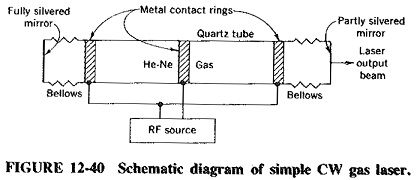Continuous Wave Gas Laser:
The first Continuous Wave Gas Laser, in 1961, was a gas laser using a mixture of helium and neon gases. These are still used, and a simplified He-Ne laser is shown in Figure 12-40.
It operates in a manner similar to that of the ruby laser, with the following differences.
1.The mirrors must be as close as possible to being ideally parallel; hence the bellows of Figure 12-40 which are used for fine adjustment.
2.The mirrors must be optically flat, to better than a wavelength, if proper laser action is to take place. This is not as exacting as might at first appear amateur reflector telescope mirrors are normally ground to an accuracy of one-eighth of a wavelength or better.
3.RF pumping is now required, at a frequency of about 28 MHz for helium-neon. Energy is discharged into the gas mixture via the ring contacts shown.
4.Emission is not at one frequency but at several so-called lines. This behavior is due in part to the atomic structure of the gases.
5.Each of the emission lines is extremely pure, having a line width of only a few hertz, each emitted frequency is extremely close to being monochromatic. In practical lasers, gas mixtures provide the narrowest lines, those of solid-state lasers are one magnitude wider and the lines of semiconductor lasers are one magnitude wider still.
6.The beam divergence from parallel is similarly less than in a ruby laser.
7.Such multi-frequency oscillation is possible because the dimensions of the resonator (i.e., the distance between the mirrors) are very much greater than a wave The behavior is exactly the same as in a simple oversized cavity resonator, capable of supporting a large number of modes.
Because pumping is continuous, unlike in the solid-state laser, continuous operation is possible. The early gas lasers operated in the infrared region and produced a few milliwatts with low efficiency. Subsequent improvements have included the use of much shorter tubes to give single rather than multiple lines, laser action with greater efficiency and in the visible spectrum and, more recently, the use of a mixture of carbon dioxide, nitrogen and helium gases. This last device operates in the far infrared spectrum at a wavelength of 10.6 μm, corresponding to a frequency of 28,300 GHz. The process has an efficiency of the order of 20 percent or more, and Continuous Wave Gas Laser powers as high as 1000 W are possible.
